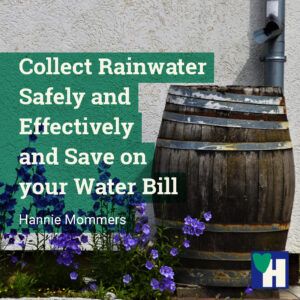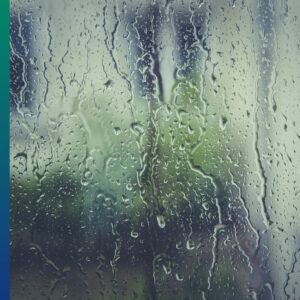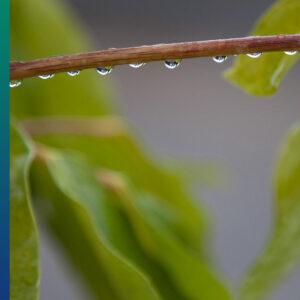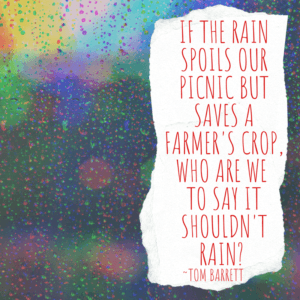
It is amazing how little a dry country like Spain does to manage rainwater. As a result, if it rains a lot, the streets are flooded and the water has nowhere to go. You would think it is not that hard to collect rainwater safely and effectively.
This is very different in the Northern European countries where it rains a lot, such as the Netherlands and Belgium. The municipalities not only attach great importance to water management, but they have various subsidy schemes for private individuals to make provisions.
On the other hand, in some countries, it is illegal to harvest rainwater for your own use! So if you want to do something with my tips, first inquire about the laws in your area.
Some of the links are affiliate links. As an affiliate associate, we earn a commission when you purchase any of the products offered through the shared links at no extra cost for you. This helps us maintain this website.
Table of contents
How do you collect rainwater safely?
Rain barrel

The good old-fashioned rain barrel is perhaps the easiest and most affordable option. You can make rain barrels yourself from waterproof containers you have lying around the home or you can purchase them online or in your local home or garden store.
While placing one or several barrels out in the rain is one option, the best way to capture the most rainwater is to position your barrel under your rain gutter downspout. Ensure that the downspout flows directly into the barrel. That way, you’re collecting all the rain that hits the roof of your home, which is a much larger surface area than a bucket collecting water in the yard.
Tap your rain barrel with two flows. One flow will be there to release overflow in the event it rains so hard that your barrel fills up. The other flow can be used to utilize the water. You can attach a hose to it and direct water into your garden, or simply have a faucet you can turn off and on to fill your watering can as needed.
The tap should be low enough to use all the water and high enough to hold a watering can or bucket underneath. Remember that water has weight, 1 liter weighs about 1 kilo, so make sure an elevation or foundation is strong enough.
Related: The Benefits of Water for the Human Body. Source of Life.
Protect the rain gutters

Place covers over your rain gutters to prevent the debris on your roof from entering your rain barrel. This debris can rot and contaminate the water. And it can clog the outputs in your rain barrel, making the use of the water extremely difficult.
Rain gutter guards and shields can be purchased at your local hardware or home store and range in price from a few dollars to a high-priced and comprehensive gutter system.
Pay close attention to how your rain gutters are set up. If you have more than one downspout, you may want to position a rain barrel under each downspout to harvest as much rainwater as possible.
Water containers

At hardware stores, you can buy water containers with more capacity than a rain barrel. Oddly enough, most containers are white so they always let in some sunlight which promotes algae growth. A dark or opaque container is better.
DIY
You can find many manuals on YouTube on how to make a water collection system yourself. If you are using a second-hand container or barrel, make sure it has previously been used for water as well. If it first contained oil or chemicals, the barrel is no longer suitable for water.
What do you use rainwater for?
Water your plants
Unless you live in an area with a lot of air pollution, rainwater is clean. It hardly contains any lime and no chlorine, which most plants love. Except for citrus plants that do like limy water.
You can water both the garden plants and the houseplants with rainwater, which saves a lot on your water bill.
Scrub the terrace and garden path

Rainwater is ideal for scrubbing the terrace and the tiles. Chlorine is bad for the environment, so if you cannot clean the tiles properly, use an organic all-purpose cleaner. If your collected rainwater is clean you can also mop the floors in the house with it.
Flush the toilet
Several public buildings in the Netherlands collect the rainwater on the roof and lead it to the toilets. Some people think it looks dirty because the water is not as crystal clear as the filtered tap water.
If a plumbing system gets too expensive, you can also use a watering can to flush the toilet. It hardly rains where we live, but I still use the watering can now and then. I collect the shower water in it while it is heating up.
Wash the car or clean the windows
If it rains where we live the water is often full of sand from the Sahara. It wouldn’t be a good idea to clean the car or the windows with that water, of course. But if you’re sure there is no sand in your rainwater it is perfect.
Do the laundry
Here the same argument applies as in the previous point, only do it when the water does not contain any sand. It wouldn’t be that bad in a hand wash, but sandy water will ruin a washing machine.
Drink it if you have taken precautions
Self-sufficient households use rainwater also as drinking water. Naturally, you must take the correct measures for this, such as filtering and algae-free storage. Make sure the water is safe before you drink it.
Related: Different Kinds of Water, Does it Matter which Water we drink?
Make a green roof
A roof covered with low-growing sedum plants will buffer the rainwater. This way, the water supply is distributed over a longer period, which is especially useful when it rains a lot.
Another advantage is that the sedum filters the water so it runs cleaner into the gutter.
An advantage, which is also a disadvantage, is that sedum filters the particulate matter from the air. An advantage because the air becomes cleaner, but a disadvantage if you collect the water for your own use.
In some countries, governments subsidize the construction of a green roof.
Some final remarks

It is important to collect and store rainwater as cleanly as possible. Algae growth in particular is something to keep an eye on.
Try to estimate how much you need so that your system is large enough. This is especially important if you want to be self-sufficient.
Shade your rain barrel or barrel.
When it hasn’t rained for a long time, the roof is dirty. If possible, don’t catch the water from your roof for the first 10-15 minutes of rain.
If you live in an area where it freezes in winter, it is better to empty the barrels before the frost sets in.
A small pump can be useful if it is not possible to raise the barrel.
Do you collect the rainwater? Will you tell us about it in the comment box below?


Hello Hannie,
Happy to know that you live in Spain and collect rainwater, too. We live in Barcelona and we collect rainwater, too. We used the huge plastic containers before in collecting the rainwater, then when we had enough money, we hired carpenters to make a huge concrete tank for the rainwater. We are now using the water for the plants and we also drink it, but my husband put a UV light to disinfect the water and an osmosis filter. But we are back to drinking from the tap using the osmosis because our tank is empty due to a lack of rain. Hoping for constant rainfall to fill our tank again.
This sounds marvelous, Julai. You are way ahead of us! But then again, we couldn’t use a huge tank as it rarely rains over here in Murcia. For the moment we are fine with the mini provisions we have. 🙂 Obviously, you have times of drought as well. Unfortunately, with the way, a lot of the Spanish farmers are handling the soil, droughts will become even more frequent.
And thanks for your tips on purifying the water! I only knew about the systems I describe in my answer to Dominique, so I have learned something new. Marvelous!
Take care and all the best.
Hi. Thanks for this article. It was a pleasure reading it.
Collecting rainwater is a good way to save money and the environment, I had never thought of this. You mentioned a lot of information on how to collect it, which is helpful for people who have never done it, like me.
However, I live in the city. Do you think it is safe for me to collect rainwater?
What are the ways to make sure that my rainwater is safe to drink? Do you know any, or do you know any websites that recommend ways to clean my water?
Hi Dominque, glad you like the article! It depends on your city, whether or not it is safe to collect rainwater for consumption. If there are a lot of traffic jams in the morning and evening, I wouldn’t use it. If the city is sort of quiet as far as car traffic is concerned, it’s better, still, I don’t know if I would feel safe enough when consuming it.
The more in the countryside, the better of course. But even then, it needs to be purified. Have a look at Julai’s comment for inspiration.
There are tablets to purify water. You can also cook it and then filter it in, for instance, a Brita filter. This is a system that lets you return the filters for reuse, so you don’t add to the plastic garbage.
A friend of mine did a solo tour of a couple of weeks on a lake in Canada. She used the lake water with purifying tablets or the rain, whenever it rained. It was good. 🙂
For the past few years, I live in a large building, so I don’t collect rainwater. However, when I was younger, we lived in a house. Back then, we would always collect rainwater in some tanks.
My father would put the tank under the roof, and he would direct the drainage system from the roof directly to that tank.
99% of the time, we used that water for our plants in the garden. That’s a great solution, especially in the summer when there are no enough rains for the plants to grow.
Fantastic that your family collects the rainwater too, Petar. The garden plants thrive so well when they get to drink rainwater. 🙂
And I know, when you live in an apartment, it’s so much harder to get things done. Especially if you rent the apartment because then you hardly have a say in the ins and outs.
If you own the apartment and there is an association of owners, much more is possible. Then you can make a joint collection of rainwater, for example. Or set up a compost point. You can even consider creating a community garden on the roof.
Where there is a will, there is a way, my mother used to say. 🙂
Thank you for your response, Petar, and take care.
My grandparents love to collect rainwater safely and effectively and they’ve been doing it for 60+ years. They do it both to consume less water and pay less for it.
Why are water containers white? I never understood this. It makes no sense since we all know a dark container is the only way to go for this purpose.
I wish more and more countries and companies would start using all the water from their roofs. We need to save and use all the water, from anywhere we can or we’ll soon find ourselves in serious trouble.
Oh, that’s so lovely, Eleonor, that your grandparents have been collecting the water for such a long time! Marvelous.
Yes, it’s crazy, isn’t it, to make water containers white, giving the algae more chance to develop. I guess they do it so you can see the level more easily, but I am also sure there are other ways to make that clear, don’t you think?
A nice fantasy: solar panels on all the roofs and rain barrels beneath them! We have noticed that the solar panels attract more condensation, making our terrace wet in the mornings. We’re still trying to figure out the best way to turn that into an advantage. 🙂
Thanks for your reaction and stay healthy.